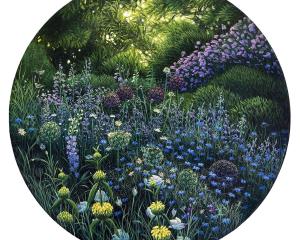"Glass Invitational New Zealand" (Milford Gallery)
Milford Gallery is currently displaying the 2009 Glass Invitational New Zealand exhibition, a remarkable display of glass sculpture at its finest.
New Zealand is rapidly gaining a reputation for fine glasswork.
Largely unhindered by the historical constraints which dominate European glassware, this country's glass sculptors produce a wide array of fascinating, innovative and breathtaking work, and artists such as Luke Jacomb, who is well-represented in this exhibition, are now widely respected both at home and overseas.
This exhibition brings together works from about a dozen top artists, ranging from vessels such as Stephen Bradbourne's finely worked white bottles and Elizabeth McClure's reclaimed laboratory flasks, through Lyndsay Patterson's large kina-inspired gourds and vessels to the purely decorative wave forms of Galia Amsel, the cool, precise cubes of John Edgar and the microbiological surfaces of Elizabeth Thomson's "Another Green World" series.
The star of the show, though, remains Jacomb.
His astonishing glass canoe paddles and patu, so clearly influenced by traditional Maori designs, have a grace and aesthetic beauty which is a delight, and the tension created from the simultaneous strength and fragility of the material adds an extra dimension to these fine pieces.
"I Have You At The Throat By Your Beauty", Ben Webb (Temple Gallery)
There is a subtle pain and sadness in the works of Ben Webb.
His images, sourced from found photographic images, show the world as a stage, a stage populated by figures whose faces seem to express the unbearable heaviness of a past trapped behind their eyes.
Webb's work has been justifiably compared to the expressionist art of Weimar Germany, a time when the real world was only slightly less gaudily tragic than the era's outlandish theatre.
Life is, in Webb's art, a dark cabaret, and this is nowhere more apparent than in the one work presented which does not conform to the artist's usual photo-realistic stylings.
In this large study, a harlequin steps out of grey Grosz-inspired streets, the gaudy patterning of his costume belying the all-too-apparent torment on his contorted face.
The other images fall into two main groups.
On one wall are clearly photographic images, overworked with subtle washes of pigment, these washes somehow seeming to express the hidden depths and scars of the characters depicted.
Opposing these are a series of ink and oil sketches, each depicting a single face.
The two series, though using widely disparate techniques, form a united theme, and it is a credit to the artist that they both achieve the same emotional impact.
"Famous Artworks", John Patrick McKenzie (Brett McDowell Gallery)
Outsider art has had a high profile recently at the Brett McDowell Gallery.
Hard on the heels of the obsessive mathematical patterns of Martin Thompson comes an exhibition by acclaimed San Francisco outsider artist John Patrick McKenzie.
McKenzie's art is created from series of short, simple (even simplistic) statements arranged together in patterns on the page.
The artist's work is largely informed by his mental condition.
McKenzie has autism, a common symptom of which is the compulsive arrangement of objects or forms in specific ways that have meaning to the sufferer alone.
In McKenzie's case, this symptom has been put to effective creative use.
His word clouds create rhythmic structures across the paper, their shapes as important as the pop culture-laden words themselves.
Characters from film and music make repeated appearances in the works, in particular the Beatles, who are the subject of several pieces.
It is true to say that outsider art in all its forms is an acquired taste, and it may be that McKenzie's exhibition will not be everyone's fancy.
It is, however, a fascinating display, and one which reveals more the closer one reads (and reads into) the lines which make up the works.








![Poipoia te Kākano [installation view]. Allison Beck, Megan Brady, Kate Stevens West, Jess...](https://www.odt.co.nz/sites/default/files/styles/odt_landscape_small_related_stories/public/story/2025/02/1_poipoia_te_k_kano.jpg?itok=ssJ8nxyx)



